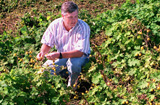Nonchemical Weed Control for Home Landscapes and Gardens
A weed is a persistent plant in your landscape that is in an undesirable location (this can include an undesired plant or a desired plant that’s outgrown its space). While there are several weed control programs, many gardeners want to manage weeds without chemicals.
A nonchemical approach requires more planning and effort, including frequent and consistent monitoring, but it can be successful. There are also many benefits to this approach, such as lower costs.
Knowing what weed species are present in your landscape will make it easier to determine which management approach is best for you. The following are the most common weed-control-options that can be used alone, with each other, or incorporated into a weed management program that involves herbicides:
Hand Pulling
Pulling weeds can be effective in some situations. (For example, you can pull weeds that are growing close to sensitive plants.) However, hand pulling can be demanding, and some weed species are difficult to pull. This is true for perennial weeds with extensive root systems, which may require multiple pulling sessions with gloves and knee pads.
This method works best when you pull weeds while they’re small and when it’s used on a regular basis.
Cultivation or Tillage
Cultivation or tillage refers to the use of a tool to remove or destroy weeds. Tools such as hoes, shovels, and knives can be used to manage small and moderate-sized areas. A rototiller or similar equipment can be used for larger areas.
This is often a better method for removing weeds that are hard to remove by hand and, similar to hand pulling, is most effective when it’s used regularly.
Mulch
In addition to suppressing weeds, mulch has many benefits, such as maintaining soil moisture and adding a finished look to landscapes. All you need is a 2 to 3 inch layer of mulch to control weeds in most situations—depths greater than 3 inches may decrease soil oxygen and harm plants.
Landscape Fabric
Landscape fabric is an increasingly popular way to prevent weeds in planting beds, but this fabric can also be used in home gardens. Landscape fabrics can be expensive, but they can suppress weeds for two or more years.
While these fabrics suppress many weed species, they may also increase the population of other weeds, such as nutsedges. It’s important to hand pull weeds that are coming through fabric before they become difficult to control.
Flaming
Flaming describes the process of high temperatures from a propane burner to burst plants’ cell walls. (Plants will quickly dry out and die when their cell wall is destroyed.) A simple way to tell if a weed will die after flaming is to briefly let the weed cool and press your thumb to the leaf—the treatment succeeded if your thumb leaves a print or smudge.
Although flaming can destroy weeds, it won’t adequately control perennial plants, grasses, or portions of the plant that aren’t above ground. Flaming can also be dangerous to the operator and desirable plants, so never burn around the base of desired plants; don’t apply flame to landscape fabric, mulch, or any other flammable material; be cautious around irrigation systems; and be careful not to melt any plastic or rubber portions of a hose.
Adapted and excerpted from:
A. MacRae, N. Boyd, and M. D'Abreau, “Nonchemical Weed Control for Home Landscapes and Gardens” (HS1170), UF/IFAS Horticultural Sciences Department (rev. 07/2013).


